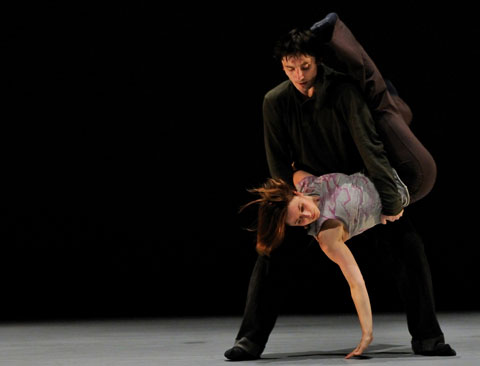
PUNTO CIEGO ABREVIADO In their duets, Anne Plamondon and Victor Quijada traveled bonelessly, without making a sound. |
Hip-hop, in common with tap dancing, can look like a succession of tricks when it's not grounded by a story or a great personality. Both traditions originated in the streets, with competitions and displays of bravado. Both have eluded the continuous throughline that makes a theatrical dance effective. Victor Quijada's choreography for Rubberbandance Group (at the ICA last weekend courtesy of CRASHarts) hovers between establishing character and showing off. It's not surprising that two of the company's dancers have worked as new-circus performers.
Rubberbandance's "Loan Sharking" is a compact edition of what the Montreal-based company does: three short takes plus a half-hour touring version of a much longer dance, Punto Ciego (called Punto Ciego Abreviado here). By the end of the performance, I'd had enough of the circular athleticism that marks the company's style, even though I also appreciated the chance to study a style being mined and refined for all it's worth.
To begin act one, we had Dr Ib Erif (Firebird spelled backward), set to the monsters' music from Stravinsky's 1910 ballet. While Fokine's squads of grotesques and captives danced in my mind, the dancers of Rubberbandance appeared in small groups and solos, and lighting designer Yan Lee Chan threw the book at them. This combination of superhuman dancing and constantly changing lighting effects held for the entire evening.
A big man who alternated soft and spastic moves, Quijada solo'd to begin Soft Watching the First Implosion, which was set to a Vivaldi cello concerto. Using the same vocabulary of pinwheel flips, spins, falls, and wormy gyrations on the floor, the other two men followed with solos of their own. Daniel Mayo seemed all coils and curves; Elon Höglund was quick and spiky.
To Dave Brubeck's "Take Five" (Attempt #2 at Reinventing the Hip Hop Routine), Karen Castleman, Emmanuelle Lê Phan, and Lila-Mae G. Talbot did the same acrobatic moves, but they worked in a close cluster, telegraphing their energy from one to the other in a chain reaction, simulating rivalry, fighting, and twisting-together camaraderie. I noticed that the women's torsos were mobile and articulate, and that they initiated the roll-arounds from the hips and pelvis, wheareas the men seemed to launch their gestures from strong arms and legs, and to use their whole torsos to do any heavy lifting and butting.
Quijada and company co-director Anne Plamondon danced the first of a long skein of duets in act two's Punto Ciego. To a mutating sound mash-up by DJ Lil Jaz (Jasper Gahunia), they engaged in a continuous dialogue of lifts, holds, and confrontations. As he made his way across the space, she fumbled and scrambled over his back and shoulders. They were traveling bonelessly, without making a sound.
Their ongoing transaction seemed impersonal until suddenly, invisibly, he maneuvered her so she was cantilevered straight out from his midsection. Later she appeared to be standing, then skipping, in midair. Then they were challenging each other with the hands-off, attack-and-avoidance moves of capoeira martial arts. He soon walked out of this game, leaving her to snake along the floor, confined and struggling in a harsh spill of light.